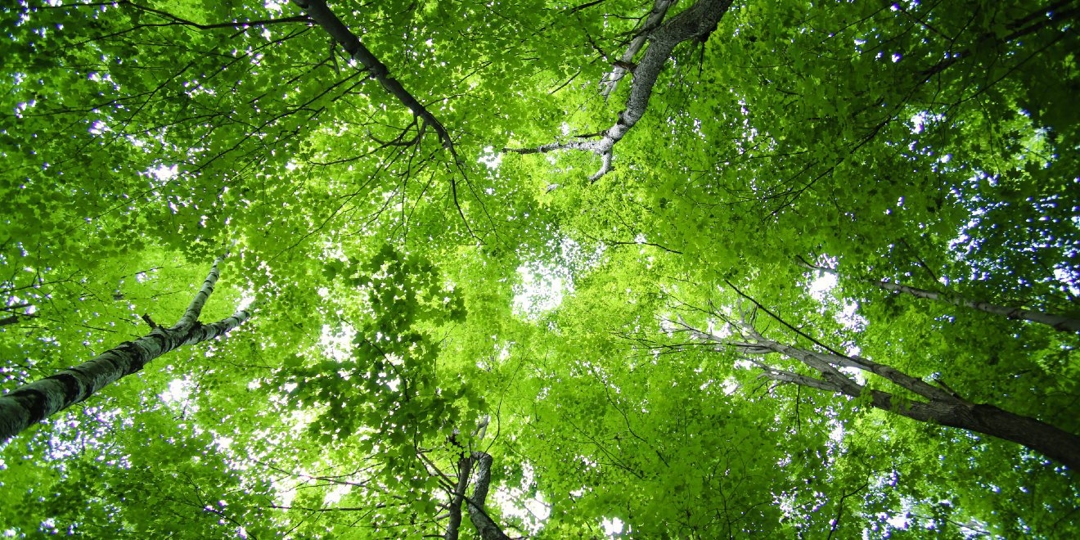When you think of backyard trees, do you think of towering oaks? Graceful willows or reaching birches? Whether you think of cottonwoods, cypress, or maples, you probably think of the same thing: green leaves on branches overhead.
If that’s what comes to mind, you’re thinking of the tree canopy! Learn all about what a tree canopy is and how you can care for yours.
A tree canopy, by definition, is the uppermost layer of branches and leaves of mature trees. It usually refers to the collective crowns of a group of trees, though you might hear people refer to one tree’s “canopy.” A tree canopy provides shade to your yard, a habitat for native animals, and a beautiful display of leaves. They can even create the ideal growing space for shade-loving trees and plants.
Canopy trees are typically over 35 feet tall when mature, with spreading branches that cover a wide area. While most people think of canopy trees as deciduous (leafy), many evergreens also count.
In suburbs and rural communities, trees shade properties while producing oxygen as part of photosynthesis (the process by which trees produce food using energy from the sun). Trees are critical as they help minimize ground erosion and can increase your property values.
The benefits of an urban tree canopy make it clear that trees aren’t just for the suburbs. In addition to benefits like oxygen production, a healthy urban canopy helps remove pollutants from the soil, air, and water. Roads and sidewalks retain heat and can increase the temperature at street level; a shady tree canopy keeps things from heating up too much and can reduce cooling costs. The tree canopy also intercepts rainfall and storm runoff, lessening damage to infrastructure.
Trees don’t run a fever, start coughing, or complain of a headache when sick or stressed, so how do we know something’s wrong? Trees often show signs of
- Overwatered trees often have limp, fragile leaves with new growth that withers or turns light green or yellow.
- Underwatered trees’ leaves will wilt, curl, or brown around the edges. Leaves may be smaller than usual and the wrong color (often yellow or brown). They could even drop their leaves too early.
- Stress can also show up as early fall color or leaves dropping too soon. Wilting, browning, a scorched appearance, and leaf spots or fungus can show that your tree is under stress. External strain can even cause the entire canopy to noticeably die back.
- Disease is exhibited via symptoms like discolored and undersized leaves, poor growth or dieback, brown or scorched leaves, an early leaf drop, spots, visible fungus growth, and multiple dead branches.
- Insect and pest damage may be visible on the leaves. Look for leaves that have many small holes in them, or which have been eaten from around the edges to catch wind of an insect infestation. Larger animals may leave more noticeable damage, such as squirrels biting off new shoots.
Once you suspect something’s wrong, it’s time to take action. A professional tree inspection tells you exactly what’s wrong so you can build a treatment plan with your local Monster Tree Service arborist. We can provide everything from a
Yes, you might see dead branches on a tree that’s otherwise perfectly healthy. If you see one dead branch or limb on an otherwise healthy-looking tree, it might just be dead as a part of a tree’s natural life cycle. Take a look at the rest of your tree’s canopy. If it shows other signs of stress or illness, like widespread dieback, undersized or discolored leaves, or spotted leaves, call a professional for help.
When you notice dead branches or overgrowth, your first instinct may be to get out the ladder and take care of it yourself. But DIY trims can be dangerous without professional knowledge and tools. Leave the canopy pruning to Monster Tree Service’s tree trimming and pruning teams. We have the proper equipment and training to remove any dead limbs and branches quickly and safely without harming your tree.
Canopy trees include any tree that grows to over 35 feet tall when mature, which encompasses a wide range of backyard trees! Some of the popular choices for creating shade include:
- Oaks
- Maples
- Cypress
- Birch
- Beech
- Willow
- Elm
- Sycamore
- Redwood
- Cypress
- American sweetgum
- American hornbeam
When you notice a tree with yellow leaves out of season or significant dieback in your tree canopy, it’s time to call in the experts. The arborists at your local Monster Tree Service can inspect your tree, diagnose the cause of your canopy issues, and recommend a treatment plan. Keep your trees vibrant and thriving when you call (518) 539-4947 or request an estimate online.

